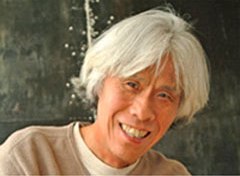Theres one small poster of Chairman Mao in Wang Huaiqing: A Painters Painter in Contemporary China, since the artist began his training in the early 60s, before the Cultural Revolution. But Wang, who recently attended the opening of his first American museum retrospective, swiftly moved beyond propaganda and into allusive, historically infused abstraction. And he keeps the politics and symbolism veiled. His large canvases often involve furniture, which seems benign. Then recall, however, that for the average Chinese peasant, furniture was historically a luxury; anyone who didnt sit on the ground was a station above you. At the same time, traditionally carved wooden furniture is also being junked in the new, booming China, whose throw-away culture is beginning to resemble our own. (See Homeless Furniture for one such example.) Wangs shattered chairssome wood scraps extend off the canvas and onto the wallallude to both those aspects Chinese tradition. Its ancient structures become blurred in modernity, the half-forgotten foundations of a partly transformed nation. BRIAN MILLER
Thursdays, 10 a.m.-9 p.m.; Wednesdays, Fridays-Sundays, 10 a.m.-5 p.m. Starts: Nov. 18. Continues through April 10, 2010




